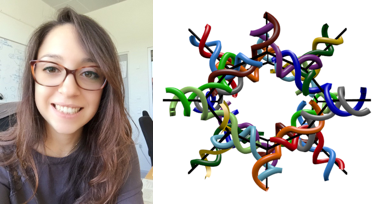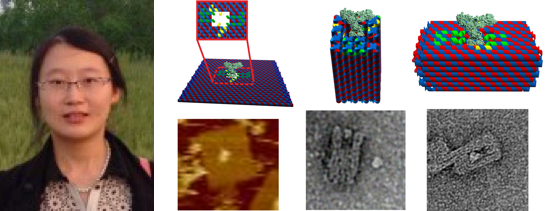Three new papers on DNA-based nanostructures and functions
Structural DNA nanotechnology is about using oligonucleotides as structural building material to create shapes and patterns with nanometer-scale precision. DNA nanotechnology studies in Gothelf Lab result in three papers where DNA constitute the architectural blocks of functional nanostructures.

A DNA 12-way junction
Dr. Ilenia Manuguerra et al. publishes a paper in ACS Nano about a novel method to assemble DNA 12-way junctions and DNA polyhedral lattices. The work was led by Gothelf-Lab in collaboration with 3 other research groups at iNANO working with DNA nanotechnology including authors Dr. Guido Grossi and Associate Prof. Ebbe S. Andersen, PhD student Rasmus P. Thomsen and Professor Jørgen Kjems, PhD student Jeppe Lyngsø and Professor Jan S. Pedersen.
The new structure has cubooctrahedron geometry and with its 12 extensions it may potentially constitute the junction in DNA-lattice with a octahedral honeycomb structure. The work furthermore introduces a new principle for assembly of DNA nanostructures (inverse-hierarchical assembly).
The paper can be found at: http://pubs.acs.org/doi/10.1021/acsnano.7b03538

Docking antibodies in DNA nanostructures
Dr. Xiangyuan Ouyang et al. presents a method to dock antibodies into cavities of DNA origami in Angewandte Chemie. The antibody is initially caught in the cavity of a designed DNA nanostructure by metal-chelation followed by covalent attachment of the antibody. This provides an approach to immobilize antibodies on a surface with control of the orientation of the antibody.
This has potential for improvement of antibody based assay technologies. The study is the result of collaboration between the Gothelf-Lab and colleagues at Shanghai Institute of Applied Physics in China.
The paper can be found at: http://onlinelibrary.wiley.com/doi/10.1002/anie.201706765/full

Molecular domino on DNA nanostructures
Dr. Sarah Helmig and Prof. Kurt Gothelf reports on a method to transfer signals across 200 nm wide DNA nanostructures in Angewandte Chemie. In the method, a path of DNA hairpin extensions are placed on a DNA origami surface. The DNA hairpin extensions can be activated to react like a domino chain reaction and transfer a signal across a distance of 200 nm. It has the potential to function as a signaling system in a complex, multi-component DNA machinery and furthermore the system represents a primitive bio-mimicking model of signal propagation in biological neurons.
The paper can be found at: http://onlinelibrary.wiley.com/doi/10.1002/anie.201706680/full

